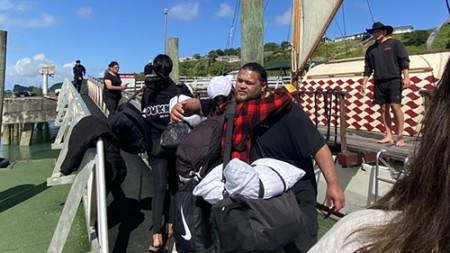"Being out here in nature, connecting with a proud Pacific heritage, sharing the science, history and stories of places that spark the imagination and feed the soul – memories like these last a lifetime."
- Captain John-Reid Willison, Te Toki Voyaging Trust

Voyagers show their appreciation for Te Toki crew.
Waka hourua are double-hulled seafaring canoes.
The fast, stable design of the modern replicas is widely believed to be similar to those that brought the first Māori settlers to Aotearoa.
With tall sails that cut an iconic profile and suspension-like lashings that flex with the waves, the style is so fine-tuned it’s still mirrored by Americas Cup-winning catamarans to this day.
Traditional knowledge of building and sailing these vessels was all but lost until the 1980s when the trans-Pacific cross-pollination of ideas from Hawaii helped spark a revival in New Zealand.

Moengaroa Solomon and Waikato Regional Council Kaihāpai Hōtaka Mātauranga Arna Solomon-Banks.
So, it was a special occasion indeed when 10 nominated rangatahi from four wharekura (full immersion secondary schools) across the Waikato got the opportunity to reconnect with their heritage and learn how to sail one for themselves.
And what better place than to do it than Kāwhia Harbour, a stone’s throw from the last landing point of the Tainui Waka, with Maketū Marae being where the waka tūpuna (ancestral canoe) is now buried.
Blue skies, gently lapping waves and a stiff breeze that seemed to rise and fall on cue greeted the eager voyagers. And they were in for a treat.
Te Maika was their destination – a remote peninsula at the southern entrance of Kāwhia Harbour with a rich history and many important archaeological sites.
Its isolated wetland habitat is home to endangered coastal plant species, migratory birds and a nationally important fossil forest.
Captains John-Reid Willison and Nohorua Ropata explained the holistic approach of Te Toki Voyaging Trust, which delivers these unique experiences on behalf of Waikato Regional Council.
“The trick to our approach is that it doesn’t feel like learning,” says John, with a knowing smile. “Being out here in nature, connecting with a proud Pacific heritage, sharing the science, history and stories of places that spark the imagination and feed the soul – memories like these last a lifetime.”
On the three-day, two-night beach-hopping adventure, the 10 intrepid rangatahi slept in the hulls of the waka as ancient voyagers would have done. They absorbed a wealth of mātauranga Māori (Māori knowledge) and consumed a lot of tasty kai, including well-received nachos courtesy of Captain John.
“Waka hourua voyages like this are about ensuring the traditional knowledge and practices of ocean navigation remains alive,” says Nohorua. “We’re sharing and celebrating these skills and training the next generation of navigators and crew. And we’re giving our rangatahi the confidence and the knowledge to be good kaitiaki for te taiao.”
The young voyagers quickly found their sea legs, learning all about the ancient anatomy of the waka, from rigging to rudder, and even getting to try their hand at the helm.
They delved into the fascinating field of marine biology, using measuring equipment to improve their awareness of the moana and native species of flora and fauna.
And they rolled up their sleeves to pitch in with beach clean-ups at both Te Waitere and Te Maika, bringing back two big bags of rubbish to help keep the local environment healthy.
Te Toki Voyaging Trust Kaumoana (crew member) William Togiaheulu says it’s a pleasure to be part of the programme and he looks forward to seeing it continue to grow.
“It’s an awesome opportunity for rangatahi to connect to te taiao and celebrate the brilliance of their tūpuna and the technology they developed to navigate the biggest ocean in the world.” The landmark educational experience was also the maiden moana voyage for the Kura Waitī Ki Kura Waitā programme, which is led and delivered by Te Toki Voyaging Trust in partnership with Waikato Regional Council.
The programme has been developed over the past three years to advance mātauranga Māori in environmental education.
Waikato Regional Council Kaihāpai Hōtaka Mātauranga Arna Solomon-Banks, along with her proud mother, Moengaroa Solomon, teachers and local aunties, welcomed the rangatahi back with a poignant karanga.
“The past three years of growing Kura Waitī Ki Kura Waitā as a progressive learning programme from the awa to the moana has been so humbling,” says Arna.
“Getting to see how the rangatahi have grown as people as the programme has grown in scale, attracting new funding and delivering new experiences, it’s just been an absolute privilege.
“The programme is delivered in te reo Māori and it’s about giving our young people the skills, knowledge and confidence to unlock exciting and rewarding career opportunities, and empowering the next generation of kaitiaki.
“Special thanks to our valued iwi partners and co-funders – the Waikato River Authority, Trust Waikato and WEL Energy Network – for their ongoing support and for helping to make this kaupapa possible.”

